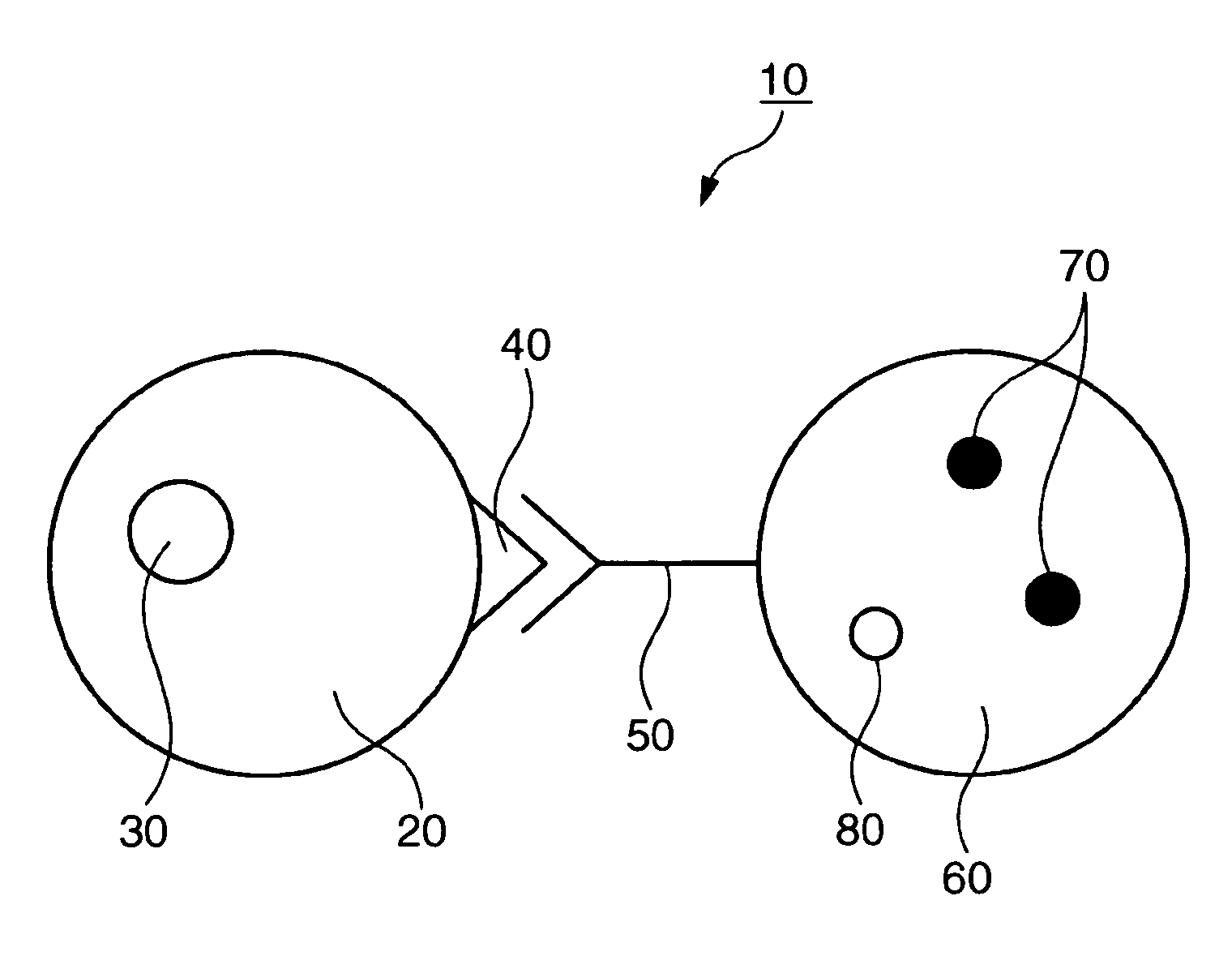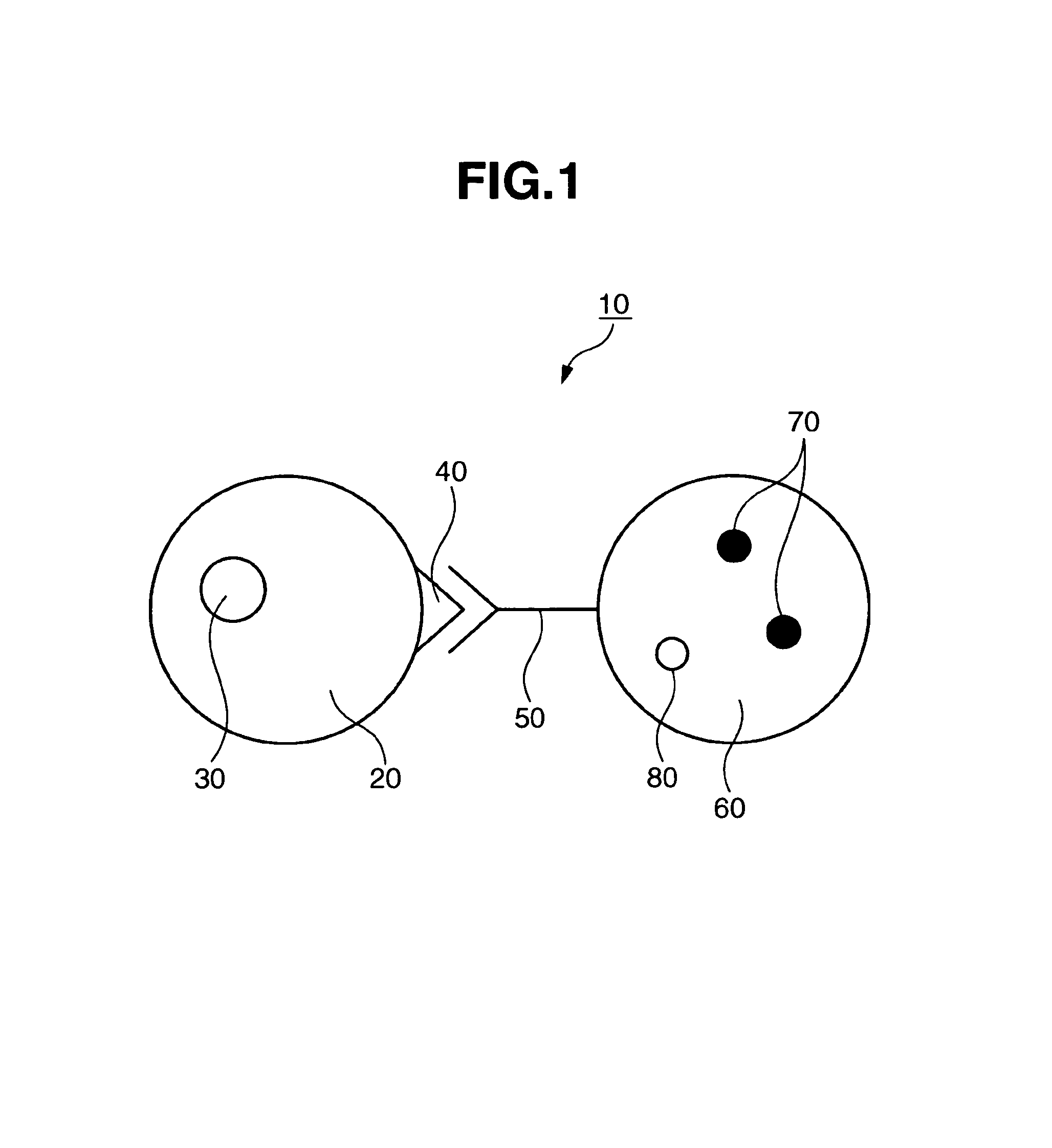Magnetic cell and method of using the same
a magnetic particle and cell technology, applied in the field of magnetic particles, can solve the problems of not having examples of magnetic particle binding to mesenchymal cells, chondrocytes or other cells which might be used in regenerative medicine, and achieve the effect of effective expression
- Summary
- Abstract
- Description
- Claims
- Application Information
AI Technical Summary
Benefits of technology
Problems solved by technology
Method used
Image
Examples
first embodiment
[0022]The magnetic cell according to the present invention is based upon the use of an adhesive component on a surface of a cell. FIG. 1 shows a schematic view of a magnetic cell 10 of the first embodiment according to the present invention. This magnetic cell 10 comprises a magnetic particle 60, which is bound via a linker 50 to glycoprotein 40 expressed on the surface of the cell 20 having nucleus 30. Examples of the glycoprotein 40 used in the present invention include, but not limited to, CD44 or HLA.
[0023]Example of the magnetic particle 60 used in the present invention includes a liposome comprising a magnetic material 70. This liposome may also contain a drug 80, which can control cell activity, and the magnetic material and the drug may also be encapsulated using another type of capsule.
[0024]Here, the liposome is a spherical double lipid layer having an aqueous interior. When the liposome is formed, a molecule present in an aqueous solution is incorporated into the aqueous ...
second embodiment
[0044]FIG. 2 shows a schematic view of a magnetic cell according to the second embodiment of the present invention. The second embodiment of the present invention uses integrin 110 present on the cell surface and peptide 120, which has adhesive activity with respect to integrin. Although not limited thereby, the aforementioned peptide may be RGDS (a peptide consisting of the four amino acids arginine-glycine-aspartic acid-serine, molecular weight 433.42).
[0045]In the second embodiment of the present invention, the magnetic cell 200 having a magnetic particle on the surface is provided through the use of activated magnetic bead 130, which is modified with the amino acid sequence of RGDS on the surface of the magnetic bead.
[0046]This magnetic cell can be prepared as follows. First, a magnetic bead the surface of which has been modified in advance with a carboxyl group is activated by means of a reagent. The reagent for activation is not particularly limited as long as it can activate ...
example 1
In Vitro Test
[0070]Myeloid mesenchymal stem cells (4×105) bound to magnetic particles which had been prepared by the above methods were spread on a petri dish. In this example, a 4300 G round (diameter 5 mm) neodymium magnet was set under the center of the dish. In the comparative example, no magnet was used. TGF-β and dexamethasone were added to the dish. After 21 days of culture, this was evaluated by toluidine blue staining. In the example, chondroid tissue had formed locally centered on a position corresponding to the magnet. In the comparative example, chondroid tissue had not formed locally.
[0071]FIG. 4 shows microscopic images (×50) observed 1 month after intra-articular injection of magnetic cells according to the present invention without (A) and with (B) the presence of an external magnetic field applied for about 72 hours. In FIG. 4(A), it is clear that the magnetic cells shown by black dots are observed throughout the cells. On the other hand, in FIG. 4(B), the magnetic ...
PUM
| Property | Measurement | Unit |
|---|---|---|
| Time | aaaaa | aaaaa |
| Time | aaaaa | aaaaa |
| Mass | aaaaa | aaaaa |
Abstract
Description
Claims
Application Information
 Login to View More
Login to View More - R&D
- Intellectual Property
- Life Sciences
- Materials
- Tech Scout
- Unparalleled Data Quality
- Higher Quality Content
- 60% Fewer Hallucinations
Browse by: Latest US Patents, China's latest patents, Technical Efficacy Thesaurus, Application Domain, Technology Topic, Popular Technical Reports.
© 2025 PatSnap. All rights reserved.Legal|Privacy policy|Modern Slavery Act Transparency Statement|Sitemap|About US| Contact US: help@patsnap.com



